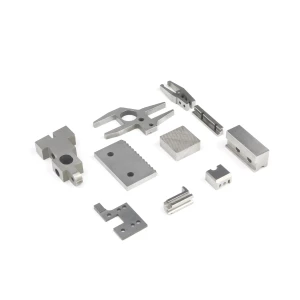The몰리브덴 평면 목표우리 회사의 고품질 판에서 가공됩니다.그것은 고밀도, 내부 균열 및 양포, 밝은 표면, 균일한 색깔 및 정확한 크기의 특성을 가지고 있습니다.
소형 몰리브덴 스피닝 목표는 고품질 막대에서 가공되며 정확한 치수, 부드러운 표면 및 높은 순수성의 특성을 가지고 있습니다.
정규 크기 몰리브덴 회전 목표는 뜨거운 동정적 압축 과정을 사용하여 생산되며 고밀도 (밀도 최대 10.15 g / cm3), 정밀한 곡물 및 좋은 성형을 특징으로 합니다.
전통적인 밀도: 10g/cm³~10.15 g/cm³;
특별한 공정 밀도: 10.15g/cm³ 이상.
사출 표적재의 요구는 전통 재료 업계보다 더 높다.일반적인 요구 사항은 크기, 플랫, 순도, 불순물 함량, 밀도, N/O/C/S, 결정 입도 및 결함 제어입니다.더 높은 요구 사항 또는 특수 요구 사항은 표면 거칠음, 저항 값, 입도 균일성, 성분 및 구조 균일성, 이물질 (산화물) 함량 및 크기, 자기 전도도, 초고밀도 및 초미세 결정 입자 등을 포함합니다.자기 제어 사출 도금막은 신형 물리 기상 도금 방법의 하나다.그것은 전자총 시스템을 사용하여 전자를 발사하고 도금할 재료에 초점을 맞추어 튀는 원자가 동량 전환 원리를 따라 더 높은 동력으로 재료를 날아갈 수 있도록 한다. 기판에 박막을 침적한다.이런 도금 재료는 사출 표적이라고 불린다.사출 표적재에는 금속, 합금, 세라믹 화합물 등이 포함된다.
마그네트론 스퍼터 코팅은 새로운 유형의 물리적 증기 코팅 방법입니다.증발 코팅 방법과 비교하면 많은 측면에서 명백한 장점이 있습니다.개발된 비교적 성숙한 기술으로서 마그네트론 스퍼터링은 많은 분야에서 적용되었습니다.
스퍼터링 기술은 스스퍼터링은 스스스스스스스스퍼터링은 스스스스스스퍼터링 기술 중 하나입니다.이온 소스에서 생성된 이온을 사용하여 진공에서 가속화하고 모여 고속 이온 고고속 고체 표면을 폭격하는 고속 이온 이이이온 광선을 형성합니다.고체 표면에 있는 이온과 원자가 생성됩니다.동적 에너지 교환은 고체 표면에 있는 원자가 고체를 떠나고 기판 표면에 沉积하게 됩니다.폭격 된 고체는 스폭폭터링 목표라고 불리는 스폭폭폭폭폭폭격 된 고체는 스폭폭터링 목표라고 불리는 스폭터폭터링에 의해 저장된 폭폭탄 폭폭탄된 고체를 준비하는 원료입니다.다양한 유형의 스퍼터링 반필름 재료는 반도체 통합회로, 태양광전지, 기록 매체, 평면 디스플레이 및 워크피스 표면 코팅에서 널리 사용되고 있습니다.
스퍼팅 목표는 통합회로, 정보 저장, 액체 결정 디스플레이, 레이저 메모리, 전자 제어 장치 등과 같은 전자 및 정보 산업에서 주로 사용됩니다.그들은 또한 유리 코팅 분야에서 사용될 수 있습니다;그들은 또한 내마모성 재료, 고온 내식성, 장식 공급 및 기타 산업에서 사용될 수 있습니다.
몰리브덴 표적은 많은 분야에 광범위하게 응용된다.다음은 몰리브덴 표적의 일반적인 몇 가지 용도입니다.
1. 1. 1. 1 1. 1 1 1. 1 1 1. 1 1 1. 1 1 1 1. 1 1 1 1 1. 1 1 1 1 1. 1 1 1 1 1. 1 1 1 1 1. 1 1 1 1 1. 1 1 1 1. 1 1. 1 1 1 1. 1 1 1 1. 1 1 1 1. 1 1 1 1 1 1.몰리브덴 몰리브덴 몰몰리브덴 몰몰리몰리몰리몰리브덴 몰몰리브덴 몰몰몰리브덴
2.진공 설비와 열장벽 코팅: 몰리브덴의 높은 용해점, 낮은 증발률과 양호한 열 안정성으로 인해 몰리브덴 표적은 텅스텐 몰리브덴 합금 밸브, 텅스텐 몰리브덴 가열기 등 진공 설비의 부품을 제조하는 데 사용할 수 있다.
또한 мол리브덴은 고온 응용 프로그램에서 재료의 내열성을 향상시키고 기본 재료를 보호하기 위해 열장벽 코팅을 준비하는 데 사용될 수 있습니다.
3. 광학적 코팅:몰리브덴 표적또한 광학 분야에서도 사용됩니다.몰리브덴의몰리브덴 필름은 적외선 분광 범위에서 좋은 반사성 특성을 가지고 있으며 따라서 적외선 광학 및 레이저 시스템에서 일반적으로 사용됩니다.
4. 전자 장치: 몰리브덴 목표는 또한 전자 장치의 제조에서 중요한 응용 프로그램을 가지고 있습니다.예를 들어, 디스플레이 기술에서 몰리브덴 필름은 좋은 전기 전도성과 열 안정성을 가진 디스플레이에 대한 백시트로 사용될 수 있습니다.
또한 мол리브덴은 전자 장치에서 접촉, 전극 및 철사 재료로 사용됩니다.
5. 물자 연구 및 실험실 응용 프로그램: 몰리브덴 목표는 또한 과학 연구 및 실험실 응용 프로그램에서 널리 사용됩니다.그것은 필름 성장, 표면 수정 및 재료 특성을 연구하기 위해 대상 재료로 사용될 수 있습니다.
또한 мол리브덴 표적은 전자 현미경 (SEM) 샘플 준비, X선 형광 분광계 (XRF) 표준 및 기타 응용 프로그램에 사용될 수 있습니다.
당신을 위해 더 많은 카테고리가 있습니다.당신이 위에서 원하는 제품을 찾을 수 없다면, 그냥 양식을 작성하고 우리에게 중국에서 수입하고 싶은 whiproducts를 말하십시오.
















